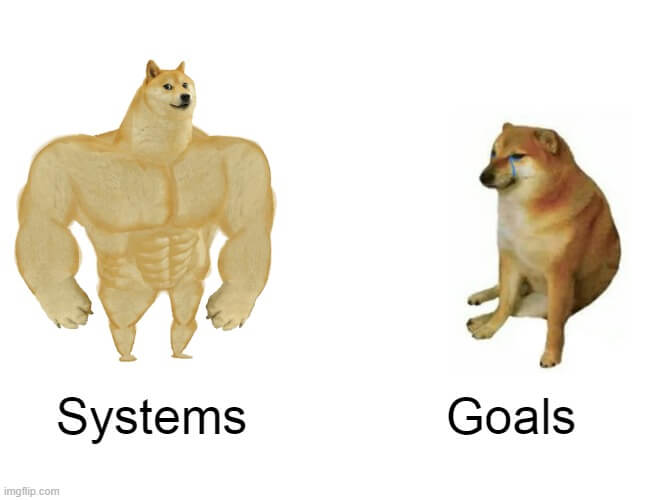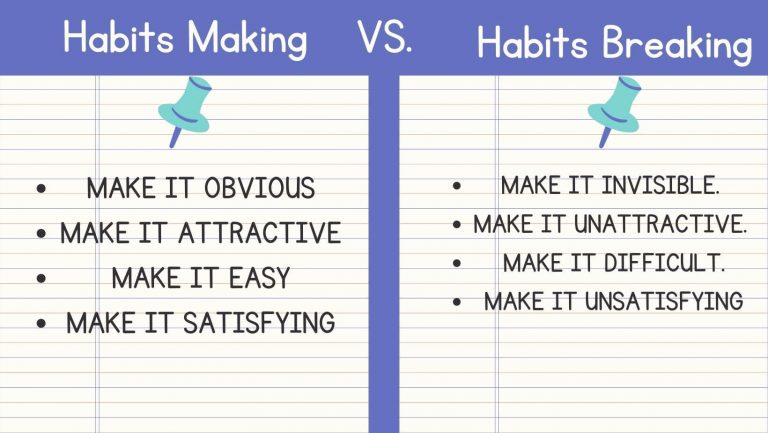Introduction
We are the summation of the habits we build. Whatever we do today at this very moment has a direct effect on our future. If you break the different tasks of your day, you will feel so many of them are automated. You perform those activities out of habit. But do these small automated habits influence our lives in any way? And if they do, how do they do it? James Clear, the author of Atomic habits, gives us a complete picture of how habits work and why the tiniest habits matter. In this Atomic Habits book summary, we will be sharing all the life-changing concepts that the author discusses.
Before moving to the six key ideas, we need to know how habits work.
How do habits work?
Every one of our habits, the good and the bad go through a 4 step process:
- Cue: The trigger that initiates the habit loop. This is the switch of the four steps that follow.
- Cravings: When the switch is turned on, a craving develops, which provides an irresistible internal force. Most often, people do not crave the habit but the reward that it provides.
- Routine: This is the actual action that you take in response to the craving.
- Reward: By completing the habit loop, you get a reward or satisfaction. This reward can be both internal or external.
Now try to incorporate these stages into one of your bad or good habits. Identify the cue, craving, routine, and reward. One of the keys to breaking/making a bad/good habit is identifying its cues, cravings, and reward ( you already know what action you perform). We will discuss more about breaking and making habits in the coming paragraphs. To give you some context, let us provide an example.
You have a bad habit of video gaming too much. What are the cue, cravings, routines, and responses?
- Cue: Either you notice your gaming console or your friend invites you to play a friendly match with him.
- Craving: You crave the entertainment and recreation gaming will provide.
- Routine: You turn your console on or visit your friend to play “just one” match of FIFA.
- Reward: You now feel the joy and satisfaction of progressing or beating your friend at the game. If you lose, you will do it again to take revenge.
This is how you can set up your habit loop. It is a mere example, but I hope now you understand how the habit loop works.

6 Lifechanging ideas from the book | Atomic habits book summary
Systems not Goals:
We all are so busy focusing on our goals we forget about the processes that will lead to it. James clear has done an amazing job explaining why goals are overrated and deserve less appreciation than they do. He highlights that people should focus on building systems that lead towards achieving their dreams.
Goal setting is easy. Everyone can do it, and most people do. But very few setup systems and processes to reach those goals. One of the key features of every successful person is that they took action in their lives.
If you love the process of studying, you are bound to become a good student. If you love the process of earning money, you will be bound to become a millionaire. Any fool can set a goal to become a millionaire, but not everyone can set up systems.
Key Idea: Don’t try to win the game; try to love the game

Get 1% better everyday
The idea of Atomic habits comes from the fact that even the smallest of actions can procure massive results. We think massive actions begets massive results, but it is far from the truth. It is the tiny actions that pile up to produce the consequences of today.
Just think, if you become 1% better every day, at the end of the year, you would be 3.66 times better than you were last year. If you continue this progress for 5-10 years, think how much development you would do in any field. We always tend to think & do big. But the reality is that even an ocean is built with millions of water drops.
Stop wondering that some big event in your life will change your life miraculously because it is not going to happen. You have to build your castle by putting in 1% extra effort every day.
Key idea: Do something to improve yourself every day

Motion Vs. Action
When you start an assignment, you start doing extensive research for it. What if you do extensive research and never actually write the assignment? Will that provide you academic progress? Obviously no. Researching about the assignment is motion while taking action to write and submit it is the actual action.
Similarly, in our lives, we are distracted by motion, and we procrastinate on the action. We tend to think we are making progress, but actually, we are not. Taking action is one of the most important steps to success. It takes immense willpower to initiate an action and even more to complete it. Most of us love to be in the stage of motion but fail to put in the extra effort of getting into the action.
Key idea: Take action of things immediately
Changing your inner beliefs and identity
One of the key ideas of this book was how our identity influences our habits. It is the reason why many people fail to give up a habit. Let me give you an example: if you consider yourself a smoker who is trying to give up smoking, then Monday or another, you are likely to fall back into your bad habit. The reason this happens is that deep inside; you still believe that you are a smoker. You have not changed your identity.
Before understanding the basics of habit breaking and forming, you should change your identity or belief. If you consider yourself a non-smoker, only then can you be a non-smoker. Changing your inner belief is the first step to a habit change. You should think, “I am the kind of person that exercises every day.” This thought will imprint in your brain, and you are far more likely to get it done. You will feel that the initial friction is also reduced to an extent.
Key idea: Change your identity
How to break and make a habit
Although this part is possibly the most important part of the book, if you haven’t internalized the previous lessons reading this part will not be of much use. In this book James Clear, the author mentions some really practical ways to break and make a habit.
To break a habit, you have to :
- Make it invisible.
- Make it unattractive.
- Make it difficult.
- Make it unsatisfying
For example, if you want to give up smoking:
- Remove cigarette packs from places where you can see them.
- Put up a poster of a damaged lung in your room in front of your bed so that you can see it every day after waking up.
- Remain accountable to your partner to make it difficult to smoke. You can also use some habit trackers that penalize you with money for breaking a habit.
- Read about lung cancer and other consequences of smoking daily to make it unsatisfying.
On the other hand, to create a good habit, you need to :
- Make it obvious
- Make it attractive
- Make it easy
- Make it satisfying
For example, you want to develop a daily habit of exercise :
- Keep your running shoes and clothes ready and within your sight
- Watch videos of people who do similar workouts and have great bodies to make them attractive
- Don’t start working hard on your first day. Take baby steps to make it easy.
- After doing exercise, try a hot shower or a premium drink for the hard work you put in to make it satisfying.

How to make a habit stick
Now you have an idea about how to break/create a habit, But the real challenge starts here. Can you stick to your habits? Will your previous identity take over your new self?
Yes, it might if you are not careful.
For sticking to a particular habit, you must keep a habit tracker until the habit becomes completely automatic. Keep a physical habit tracker that you can see every day. This tracker will produce a cue not to break the chain and continue the habit every day.
Many good habits break apart because of a change of environment. If you move from your own house to your dormitory, there is a high chance your good habits will not stick. The best thing you can do is remodel your new environment to something very similar to the old one. This will play a vital role in maintaining your habit even in a new environment.
Key idea: Making a good habit is easy; sticking to it is the difficult part.
These are the six ideas that may change your life for the better if you implement them right. You may change any habit or form new ones by these methods.
Top 8 quotes from the book | Atomic Habits book summary
Here are some of the quotes from atomic habits that I found really powerful.
- You do not rise to the level of your goals. You fall to the level of your systems
- Habits are the compound interest of self-improvement
- Sometimes the best is the enemy of the good.
- Professionals stick to their schedule; amateurs let life get in their way
- Every action you take is a vote for the type of person you want to become
- Be the designer of your world and not merely the consumer of it
- All big things come from a small beginning
- Success is the product of daily habits -not once in a lifetime transformations
Wrapping up
Atomic habit is an amazing book for self-development. It will change the way you think and live. If you are a person who is looking to direct your life for the better, this book is the place to start.
This book gives you an idea of how powerful your daily habits are and how to guide them. Our bad habits can become our enemies if we don’t change them with good ones. Hope this summary provides you with an insight of you can put your atomic habits to better use.


